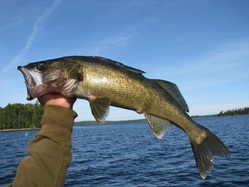Fishing

Those considering fishing in Missouri River Country should think big. Defined by sandstone formations, fields of grain and fertile river bottoms, this is a place where shorelines go on for more than a thousand miles and fish grow to more than 100 pounds. This is the land where men built a dam across the mighty Missouri River and created the largest body of water in Montana. This is the land of Fort Peck Reservoir.
Ft Peck Reservoir
More than 50 different species of fish live in Fort Peck and they all have room to grow. The reservoir is 134 miles long and as much as 220 feet deep. Along its 1,600 miles of shoreline and under its 240,000 acres of surface area, walleye, northern pike, small-mouth bass, lake trout and Chinook salmon are waiting. Curious looking ling, prehistoric paddlefish and two species of sturgeon abide there too.
Missouri and Yellowstone Rivers
The Missouri and Yellowstone rivers cut through dramatic landscapes here. Both are thick with their own possibilities-including the chance to land more than 100 pounds of something harkening back to another time. Ancient paddlefish of enormous size can still be found in both rivers. On the Yellowstone, seek them out near Sidney; on the Missouri, look between the Fred Robinson Bridge to the head of Fort Peck Reservoir. Fishing for these creatures requires an additional state license, big treble hooks, heavy weights and a deep-sea rod.
Nelson Reservoir
Another great angling spot is Nelson Reservoir, the experts’ pick for the best walleye fishing in Montana and home to record-setting pike and yellow perch.
Medicine Lake
Northern pike inhabit Medicine Lake and some of the surrounding lakes and ponds. Fishing for these predatory fish is best from late fall through the early spring. Fishing or spearing from inside an icehouse is preferred during winter, but fishing from shore or non-motorized boat is a good option in other seasons.

